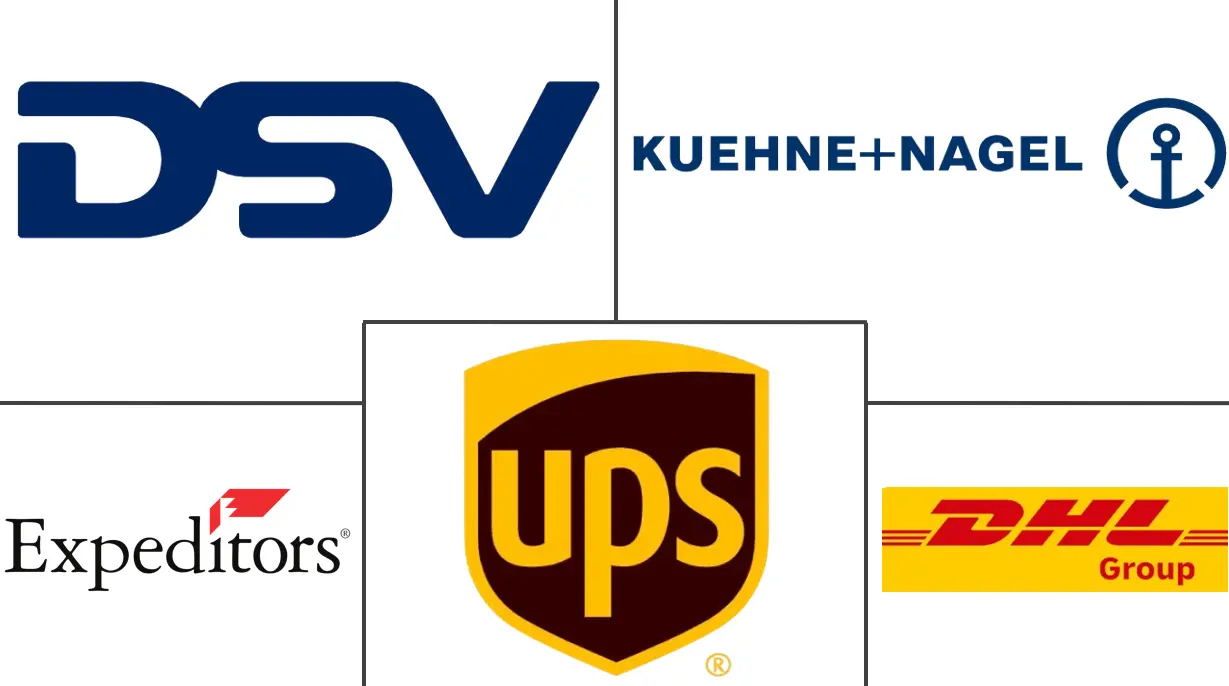Air Freight Forwarding Market Size and Share
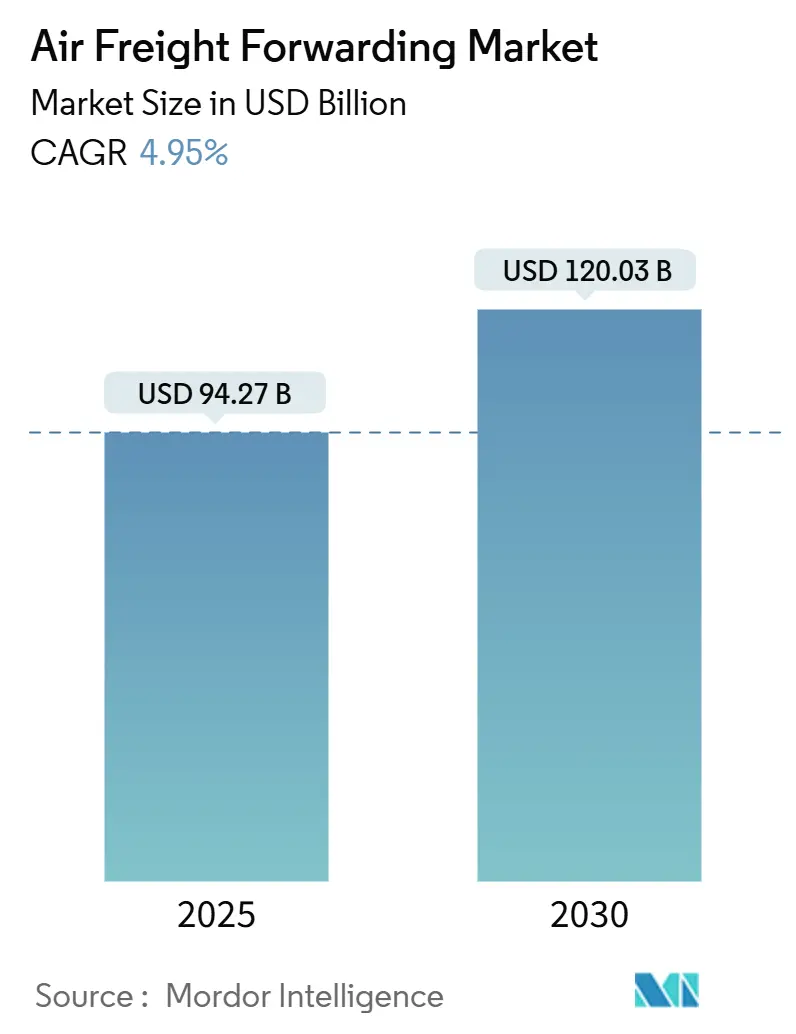
Air Freight Forwarding Market Analysis by Mordor Intelligence
The Air Freight Forwarding Market size is estimated at USD 94.27 billion in 2025, and is expected to reach USD 120.03 billion by 2030, at a CAGR of 4.95% during the forecast period (2025-2030).
Growth stems from resilient cross-border e-commerce, a surge in temperature-controlled pharmaceuticals, and sustained freighter-conversion programs that counteract belly-hold capacity shortages. Competitive activity is marked by scale-seeking mergers, with the DSV–Schenker combination reshaping pricing power and contract negotiations across major trade lanes. Digitalization, including real-time cargo-visibility tools, improves service reliability and enables premium pricing. At the same time, sustainability mandates and volatile jet-fuel costs complicate forwarders’ margin management and prompt strategic capacity diversification.
Key Report Takeaways
- By cargo type, general cargo led with 62% of the air freight forwarding market share in 2024. Special cargo and others are projected to record the highest 4.50% CAGR through 2030.
- By end-user industry, e-commerce and retail held 28.22% share of the air freight forwarding market size in 2024, while healthcare and pharmaceuticals are set to expand at a 5.70% CAGR out to 2030.
- By destination, international shipments accounted for 80% of 2024 revenues and are tracking a 4.20% CAGR to 2030.
- By geography, Asia-Pacific captured a 35% share of 2024 revenues, and the region is advancing at a 5.30% CAGR over the forecast period.
Global Air Freight Forwarding Market Trends and Insights
Drivers Impact Analysis
| Driver | (~) % Impact on CAGR Forecast | Geographic Relevance | Impact Timeline |
|---|---|---|---|
| Global e-commerce boom | +1.2% | Global with Asia-Pacific leading | Medium term (2-4 years) |
| Near-shoring & time-critical supply-chains | +0.8% | North America & EU | Medium term (2-4 years) |
| Growth in temperature-controlled & high-value cargo | +0.7% | Global, concentrated in developed markets | Long term (≥ 4 years) |
| Freighter conversions unlocking latent capacity | +0.5% | Global with Asia-Europe focus | Short term (≤ 2 years) |
| Real-time cargo-visibility platforms enabling premium pricing | +0.4% | Developed markets | Medium term (2-4 years) |
| Secondary-airport cross-border e-commerce hubs | +0.3% | North America, select APAC markets | Long term (≥ 4 years) |
| Source: Mordor Intelligence | |||
Global E-commerce Boom
Cross-border e-commerce now represents more than 50% of Asia-originating air cargo volumes, compressing peak-season timelines and amplifying forwarder demand for express capacity. It is forecasted that global online retail penetration to reach 24% worldwide and 26% in the United States by 2025, reinforcing demand for fast transit solutions that favor air over ocean. The scheduled removal of the U.S. de minimis exemption on August 29, 2025, increases customs-clearance complexity and is expected to lift international parcel volumes as shippers consolidate shipments to reduce compliance burdens. Forwarders respond by reallocating block-space agreements toward lanes with high small-parcel density, particularly Asia–North America, while deploying API-based booking engines that shorten quotation cycles. These dynamics raise yield volatility yet reward operators that can flex network capacity to seasonal surges.
Near-shoring & Time-Critical Supply-Chains
Regionalization of manufacturing has spawned new North America–centric corridors as companies prioritize resilience over lowest-cost sourcing, pushing secondary U.S. airports such as San Bernardino International and Wilmington Air Park to record cargo growth in 2024 and 2025. Near-shoring dynamics shift volume away from congested coastal gateways toward inland facilities that offer faster truck-to-air transfers, enhancing supply-chain agility for high-value electronics and automotive components. Cross-border hubs in Tijuana and Phoenix-Mesa Gateway Airport illustrate how specialized infrastructure accelerates Mexico–U.S. e-commerce flows. Distributed networks mitigate slot constraints at tier-1 airports and disperse geopolitical risk. Forwarders leverage these routes to differentiate service offerings aimed at customers seeking shorter replenishment cycles.
Growth in Temperature-Controlled & High-Value Cargo
Pharmaceutical volumes rose 22% at IAG Cargo and 25% at Emirates SkyCargo in 2025, reflecting rising demand for stringent temperature compliance[1]Air Cargo Week Staff, “IAG Cargo reports 22 percent surge in pharmaceutical shipments,” Air Cargo Week, aircargoweek.com. Personalized medicine and cell-therapy shipments require ultra-cold chain custody, underpinning premium yields that exceed general cargo rates by multiples. UPS enhanced its cold-chain services to cover multiple temperature bands and incorporate real-time monitoring that lowers excursion risks. Pharmaceutical shippers also pursue reusable packaging solutions, expected to scale from 30% to 70% adoption, which improves sustainability credentials and threatens one-way packaging suppliers. Forwarders with certifications such as GDP and CEIV Pharma secure competitive moats because regulatory oversight grows stricter in mature markets.
Freighter Conversions Unlocking Latent Capacity
Post-pandemic conversion programs have introduced aircraft such as the A321P2F, delivering 55% more containerized space than earlier narrowbody freighters. Airbus projects demand for 1,000 small-freighter conversions over two decades, easing capacity imbalances created by reduced passenger belly space. Operators like Atlas Air are committed to eleven additional aircraft and a 55-year lease at Anchorage to anchor Asia–North America flows. Converted freighters offer route flexibility unattainable for passenger carriers, enabling forwarders to deploy point-to-point services that bypass congested hubs. Conversion pipelines diversify fleet composition and mitigate exposure to OEM delivery delays for new-build freighters.
Restraints Impact Analysis
| Restraint | (~) % Impact on CAGR Forecast | Geographic Relevance | Impact Timeline |
|---|---|---|---|
| Volatile jet-fuel prices | -0.8% | Global, higher on long-haul routes | Short term (≤ 2 years) |
| Sustainability-driven modal shift to sea & rail | -0.6% | Europe, expanding to North America | Long term (≥ 4 years) |
| Slot constraints at tier-1 cargo airports | -0.4% | North America, Europe, Asia | Medium term (2-4 years) |
| Cyber-security risks in digital forwarding platforms | -0.2% | Global, digitally advanced markets | Medium term (2-4 years) |
| Source: Mordor Intelligence | |||
Volatile Jet-Fuel Prices
IATA projects average jet-fuel at USD 87 per barrel in 2025 versus USD 99 in 2024, yet fuel still accounts for 26.4% of airline operating costs, putting pressure on forwarder procurement margins. Sustainable Aviation Fuel mandates elevate cost variability because SAF trades at a significant premium to kerosene. Production volumes are slated to reach 713.26 million gallons in 2025, but supply limitations keep prices elevated. Forwarders hedge exposure through index-linked contracts, yet smaller shippers often resist fuel-surcharge escalations, squeezing margins. Net-zero commitments press carriers to adopt SAF irrespective of cost, embedding structural price risk into air cargo economics.
Sustainability-Driven Modal Shift to Sea & Rail
Pharmaceutical manufacturers now route more than 50% of products by sea to balance cost and emissions, underscoring mode-substitution risks facing air freight. The EU Corporate Sustainability Reporting Directive requires roughly 50,000 firms to disclose transport emissions from 2025, with fines up to EUR 10 million (USD 10.4 million) for non-compliance. Comparable rules in the United Kingdom set a 2% SAF mandate in 2025, rising to 22% by 2040, escalating the relative cost of air freight. Corporations face reputational risk when using high-carbon modes for non-urgent cargo, tilting procurement policies toward greener transport where feasible.
Segment Analysis
By Cargo Type: General Cargo Dominance Faces Specialized Growth
General cargo accounted for 62% of 2024 revenues, anchoring the air freight forwarding market size through volumes generated by electronics, apparel, and spare parts[2]Centre for Aviation Analysts, “Anchorage airport: an east-west hub,” CAPA, centreforaviation.com. Its growth rate remains modest as pricing competition intensifies and modal shift options proliferate. Special cargo and others are expected to climb at a 4.50% CAGR (2025-2030) because temperature-controlled pharmaceuticals, dangerous goods, and high-value electronics demand elevated service standards. This segment benefits from regulatory moats created by IATA and ICAO rules that limit new entrant penetration and underpin attractive yields.
Freighter conversions have disproportionate benefits for special cargo because main-deck access and specific load configurations accommodate outsized items better than belly holds. DHL’s 2025 acquisition of CRYOPDP, which manages more than 600,000 clinical-trial and biopharma shipments annually, demonstrates strategic investment in special-cargo capacity. General cargo retains resilience from the e-commerce surge, but margin dilution persists as shippers commoditize basic services. Specialized cargo, by contrast, maintains pricing power that shields operators from fuel-surcharge debates, contributing positively to the air freight forwarding market share held by high-service providers.
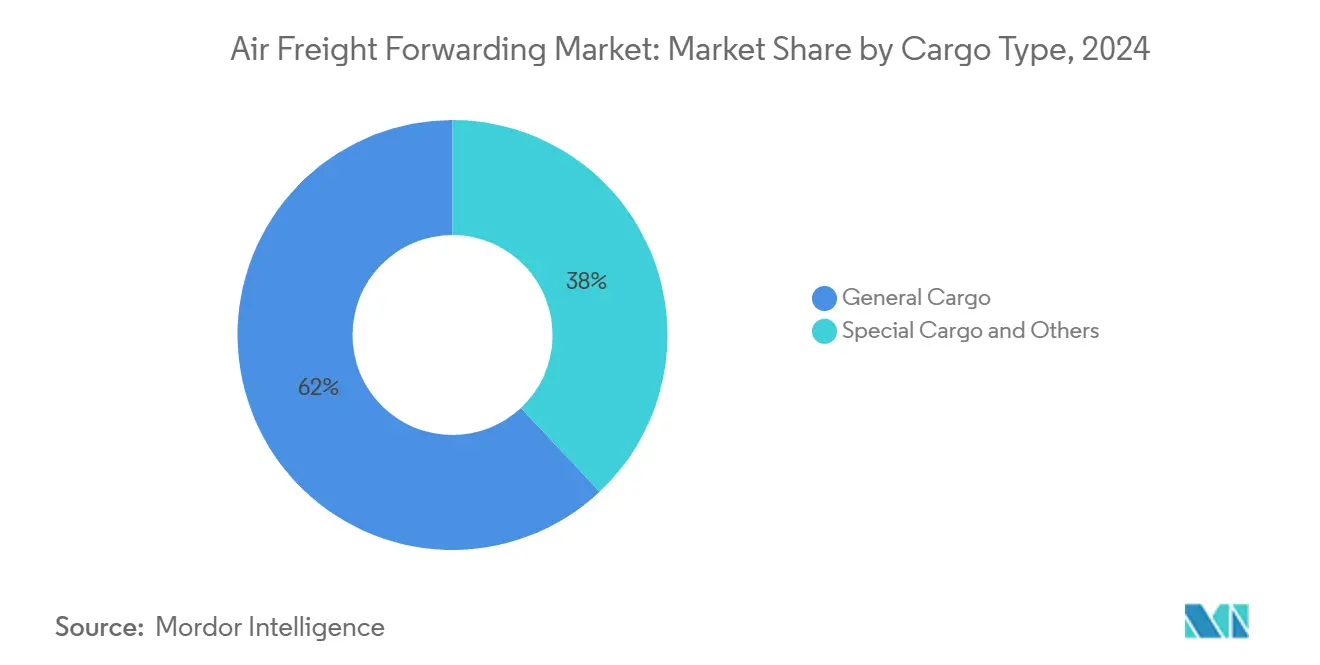
By Destination: International Dominance Reflects Global Integration
International routes captured 80% of 2024 revenue and is projected to sustain a 4.20% CAGR (2025-2030) as cross-border trade continues to grow despite geopolitical friction. Customs-clearance complexity and higher security requirements elevate service value, supporting premium yields. Secondary-airport initiatives create new international corridors that bypass congested hubs and speed last-mile delivery into key consumption centers.
Domestic air freight contends with sustainability mandates encouraging modal substitution to rail and truck for short distances, pressuring growth potential in Europe and parts of Asia. Nonetheless, domestic networks still play a pivotal role in large geographies such as the United States and China, where e-commerce giants require overnight coverage. Slot constraints at mega hubs encourage forwarders to integrate road-feeder services that complement air legs, aligning network design with evolving customer lead-time expectations.
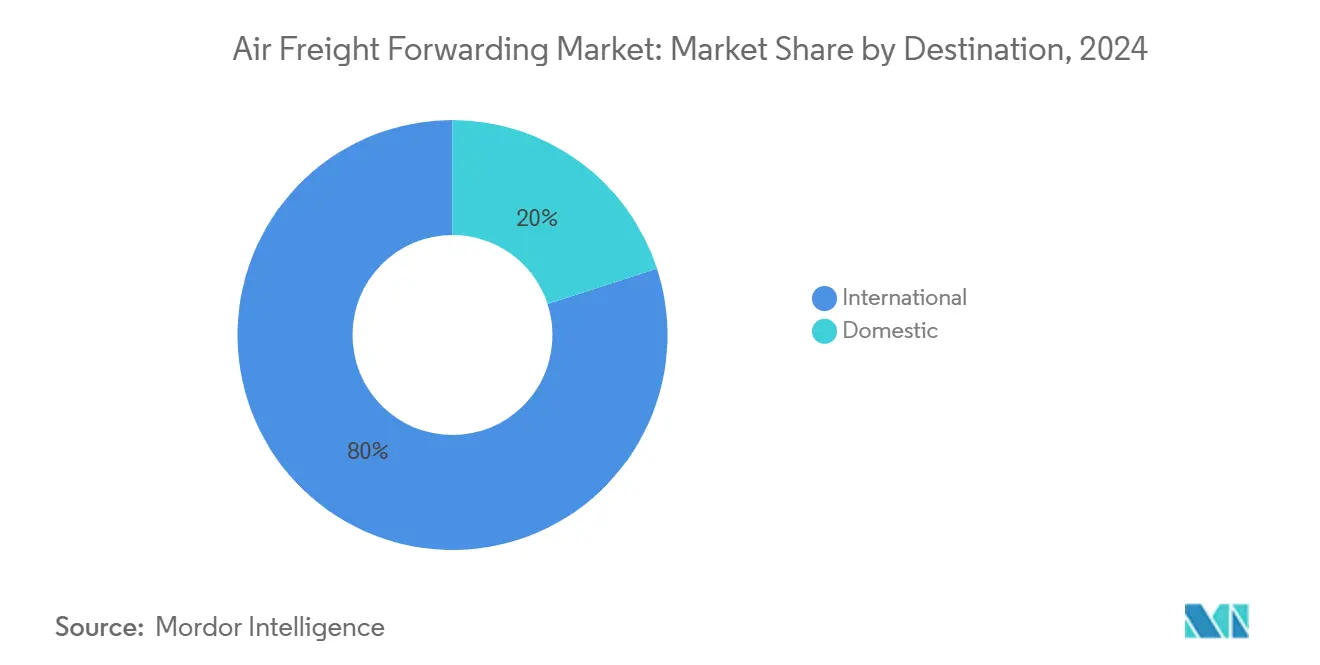
By End-user Industry: Healthcare & Pharmaceuticals Lead Growth Trajectory
E-commerce and retail formed the largest end-user block at 28.22% of 2024 sales, buoyed by surging direct-to-consumer demand and rapid fulfillment expectations. Healthcare and pharmaceuticals are expected to deliver the fastest 5.70% CAGR (2025-2030), reflecting the proliferation of biologics and gene therapies that require strict temperature control and qualified handling procedures. Higher value-to-weight ratios justify air transport costs, reinforcing specialized service adoption.
Manufacturing and automotive segments face mixed outlooks; near-shoring reduces long-haul moves but increases intra-regional expedited shipments for supply-chain recovery. High-tech and electronics retain growth momentum due to shorter product cycles and miniaturization that heightens value density. Perishables and fresh produce emerge as growth themes given improving cold-chain networks that extend shelf life and expand export reach from Latin America to major consumer markets. Forwarders deploy dedicated pharma corridors with GDP-certified facilities, strengthening differentiation in a segment where compliance expertise directly correlates with customer retention.
Geography Analysis
Asia-Pacific accounted for 35% of global revenues in 2024 and is projected to advance at a 5.30% CAGR (2025-2030), propelled by China’s export engine, India’s 6–9% projected cargo growth, and intra-regional e-commerce expansion. Wide-body freighter scarcity in India offers growth prospects for forwarders that can deploy capacity quickly, while hubs like Anchorage enable efficient trans-Pacific transfers[3]IATA, “IATA & ICAO extend cooperation on dangerous goods,” IATA, iata.org.
North America maintains a significant share through embedded e-commerce infrastructure and near-shoring trade with Mexico and Canada. Regional gateways expand to accommodate time-critical flows, with San Bernardino and Wilmington illustrating how inland airports capture volumes that once funneled through Los Angeles or New York. Sustainability pressures are lower relative to Europe, granting growth runway for express freight services.
Europe faces tighter environmental regulations that nudge shippers toward sea or rail for non-urgent cargo. Still, pharmaceuticals and high-value electronics sustain air freight demand, and carriers leverage joint ventures to optimize capacity amid stringent slot allocations. The Middle East and Africa serve as connective hubs linking Asia, Europe, and Africa. Investments in data centers and e-commerce infrastructure, paired with the region’s geographic advantage, foster specialized freight flows for IT equipment and perishables.
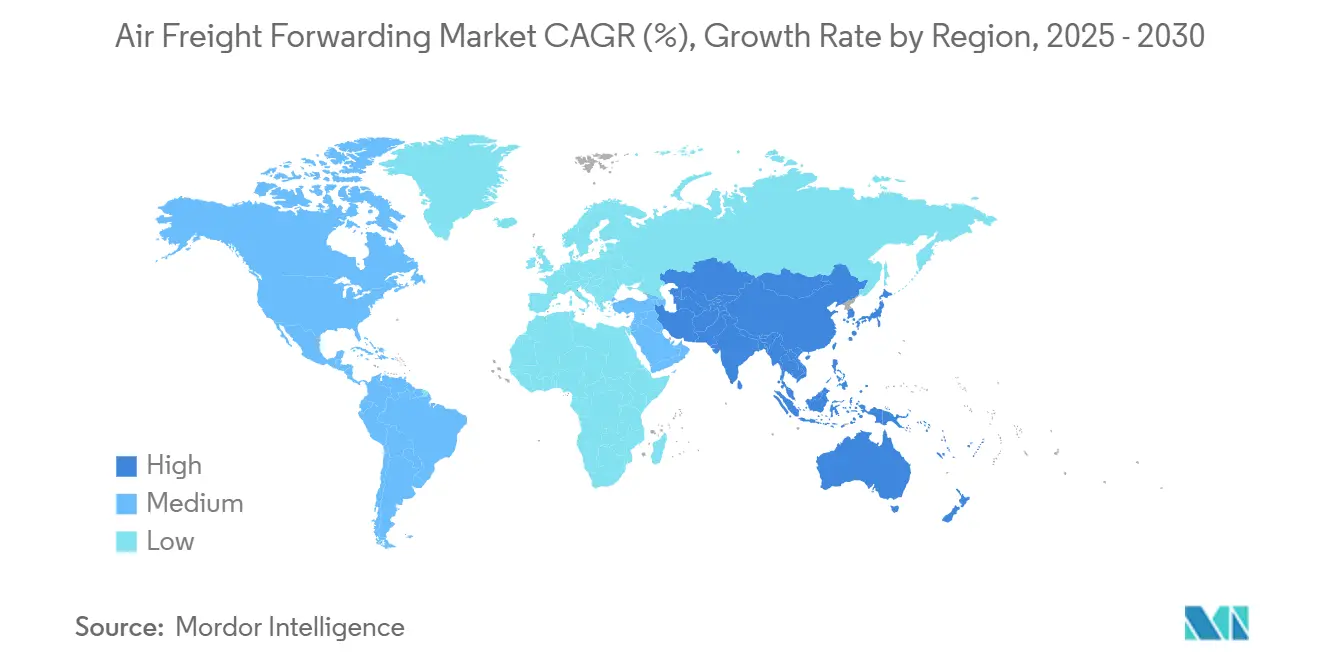
Competitive Landscape
The air freight forwarding market remains moderately fragmented; however, industry consolidation accelerated when DSV closed the USD 15.3 billion Schenker deal in April 2025, creating a logistics giant with EUR 41.6 billion (USD 43.3 billion) in combined turnover and almost 160,000 staff in more than 90 countries. The transaction pushes smaller forwarders to specialize in niche cargo types or digital platforms to remain competitive.
Digitalization defines strategic differentiation. Signatories to the IATA digital charter use standardized data frameworks to reduce errors and speed document processing, translating into more predictable door-to-door transit times. Start-ups focus on algorithmic pairing of freight with latent capacity, especially at secondary airports where pricing flexibility is higher.
Specialized logistics capabilities command premium valuations. DHL’s purchase of CRYOPDP enhances pharmaceutical cold-chain scale and underlines the attractiveness of regulated segments where barriers to entry are strong. CEVA, Kuehne + Nagel, and Nippon Express pursue targeted acquisitions to deepen geographic reach and technology integration. Competitive intensity, therefore, shifts from pure price competition toward service scope and regulatory compliance.
Air Freight Forwarding Industry Leaders
-
DHL Supply Chain & Global Forwarding
-
Kuehne + Nagel
-
DSV
-
UPS Supply Chain Solutions
-
Expeditors International
- *Disclaimer: Major Players sorted in no particular order
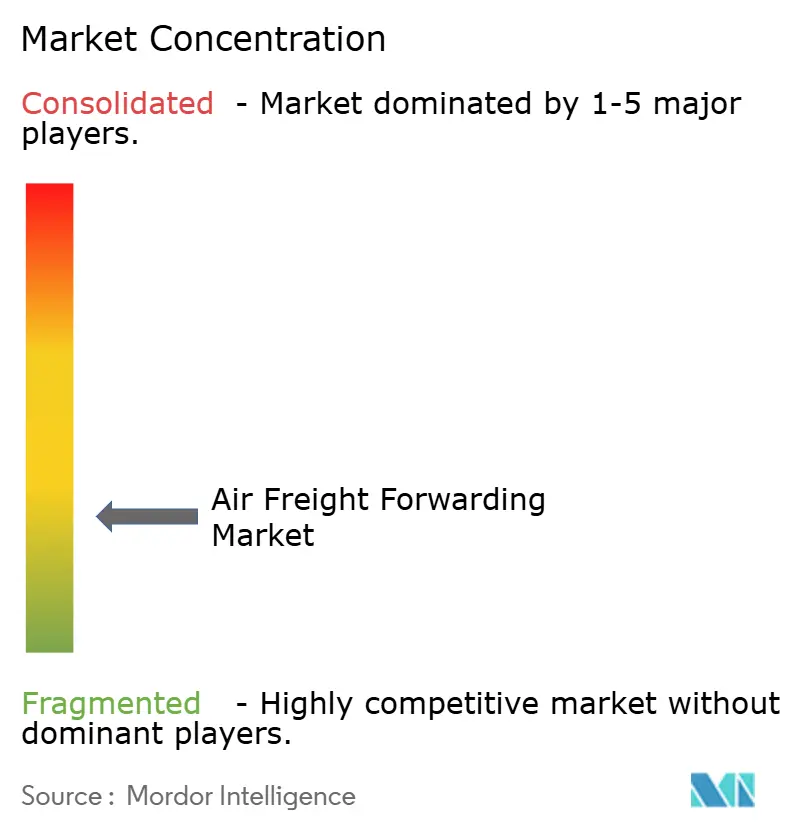


Recent Industry Developments
- June 2025: DHL Global Forwarding inaugurated a 24,500 m² air freight hub at Frankfurt Airport capable of processing 300,000 tons annually.
- April 2025: DSV completed its USD 15.3 billion acquisition of DB Schenker, creating the sector’s largest logistics firm.
- April 2025: CEVA Logistics agreed to acquire Borusan Tedarik for USD 440 million, adding 570,000 m² of warehousing in Turkey.
- January 2025: Expeditors International partnered with Dubai South to establish a new 23,200 m² logistics facility in Dubai’s Logistics District.
Global Air Freight Forwarding Market Report Scope
Air freight is another name for air cargo, which is the shipment of goods via an air carrier. The value of air transport services is highest when it comes to the transportation of express shipments around the world. Like commercial or passenger air carriers, air freight operates through the same gateways.
The report provides a comprehensive background analysis of the market, covering the current market trends, restraints, technological updates, and detailed information on various segments and the competitive landscape of the industry. Additionally, the COVID-19 impact has been incorporated and considered during the study. The Air Freight Forwarding market is segmented by service (airlines, mail, and other services), destination (domestic and international), Geography (North America, Europe , Asia-Pacific , Middle East & Africa , South America). The report offers the market sizes and forecasts for the Air Freight Forwarding Market in value (USD) for all the above segments.
| General Cargo |
| Special Cargo and Others |
| International |
| Domestic |
| E-commerce & Retail |
| Manufacturing & Automotive |
| Healthcare & Pharmaceuticals |
| Perishables & Fresh Produce |
| High-Tech & Electronics |
| Others |
| North America | United States |
| Canada | |
| Mexico | |
| South America | Brazil |
| Peru | |
| Chile | |
| Argentina | |
| Rest of South America | |
| Asia-Pacific | India |
| China | |
| Japan | |
| Australia | |
| South Korea | |
| South East Asia (Singapore, Malaysia, Thailand, Indonesia, Vietnam, and Philippines) | |
| Rest of Asia-Pacific | |
| Europe | United Kingdom |
| Germany | |
| France | |
| Spain | |
| Italy | |
| BENELUX (Belgium, Netherlands, and Luxembourg) | |
| NORDICS (Denmark, Finland, Iceland, Norway, and Sweden) | |
| Rest of Europe | |
| Middle East and Africa | United Arab of Emirates |
| Saudi Arabia | |
| South Africa | |
| Nigeria | |
| Rest of Middle East And Africa |
| By Cargo Type | General Cargo | |
| Special Cargo and Others | ||
| By Destination | International | |
| Domestic | ||
| By End-user Industry | E-commerce & Retail | |
| Manufacturing & Automotive | ||
| Healthcare & Pharmaceuticals | ||
| Perishables & Fresh Produce | ||
| High-Tech & Electronics | ||
| Others | ||
| By Geography | North America | United States |
| Canada | ||
| Mexico | ||
| South America | Brazil | |
| Peru | ||
| Chile | ||
| Argentina | ||
| Rest of South America | ||
| Asia-Pacific | India | |
| China | ||
| Japan | ||
| Australia | ||
| South Korea | ||
| South East Asia (Singapore, Malaysia, Thailand, Indonesia, Vietnam, and Philippines) | ||
| Rest of Asia-Pacific | ||
| Europe | United Kingdom | |
| Germany | ||
| France | ||
| Spain | ||
| Italy | ||
| BENELUX (Belgium, Netherlands, and Luxembourg) | ||
| NORDICS (Denmark, Finland, Iceland, Norway, and Sweden) | ||
| Rest of Europe | ||
| Middle East and Africa | United Arab of Emirates | |
| Saudi Arabia | ||
| South Africa | ||
| Nigeria | ||
| Rest of Middle East And Africa | ||


Key Questions Answered in the Report
What is the current value of the air freight forwarding market?
The market is valued at USD 94.27 billion in 2025.
How fast is the sector expected to grow?
It is projected to expand at a 4.95% CAGR and reach USD 120.03 billion by 2030.
Which cargo type is expanding the quickest?
Special cargo, including temperature-controlled pharmaceuticals and high-value goods, is growing at a 4.50% CAGR.
Which end-user group shows the highest growth rate?
Healthcare and pharmaceuticals lead with a 5.70% CAGR through 2030.
Why are freighter conversions important?
Conversions add cost-effective capacity that compensates for reduced passenger belly space and improve flexibility on key routes.
Which region commands the largest share?
Asia-Pacific holds 35% of global revenue and registers the fastest regional CAGR at 5.30%.
Page last updated on:
